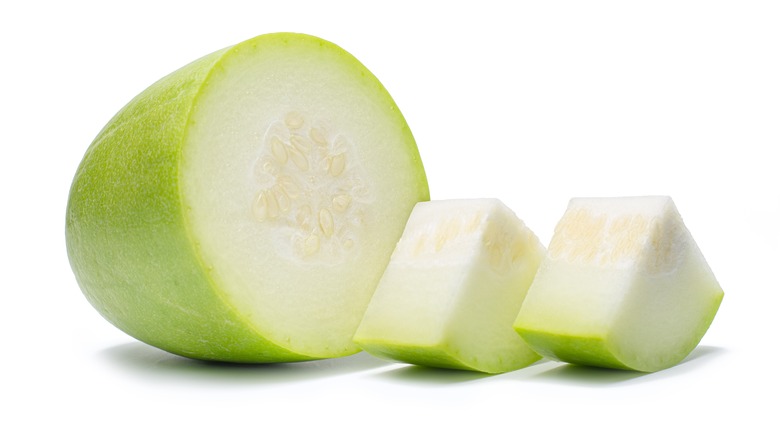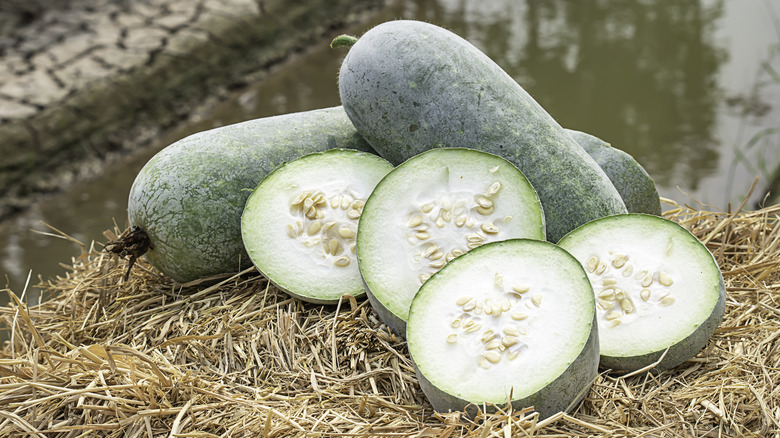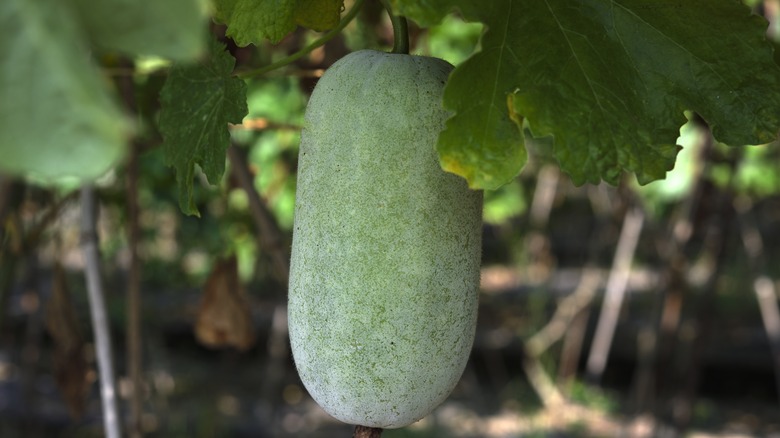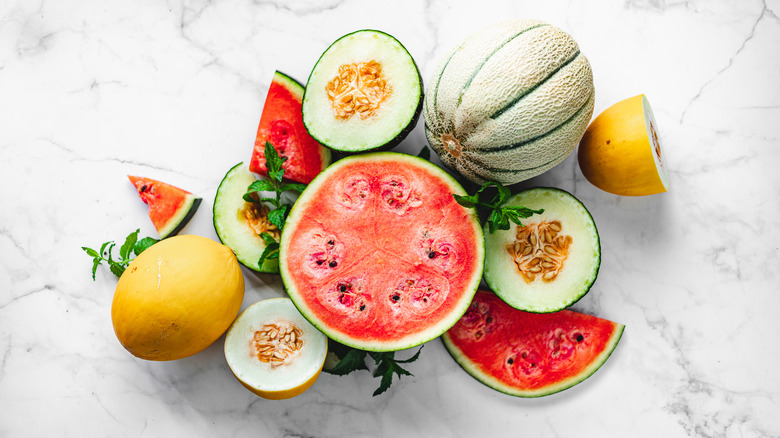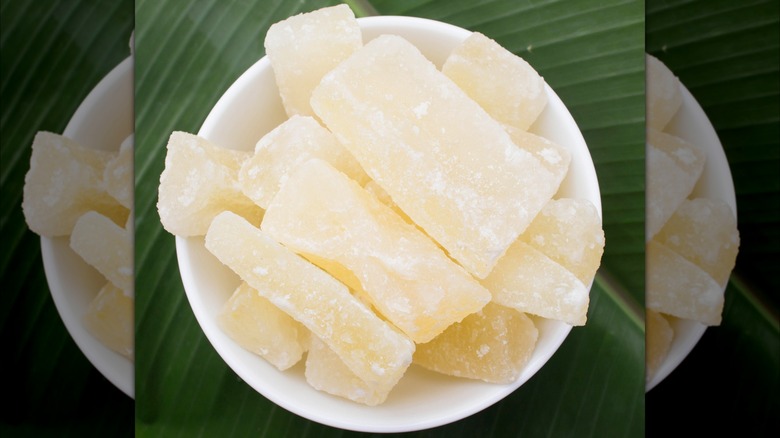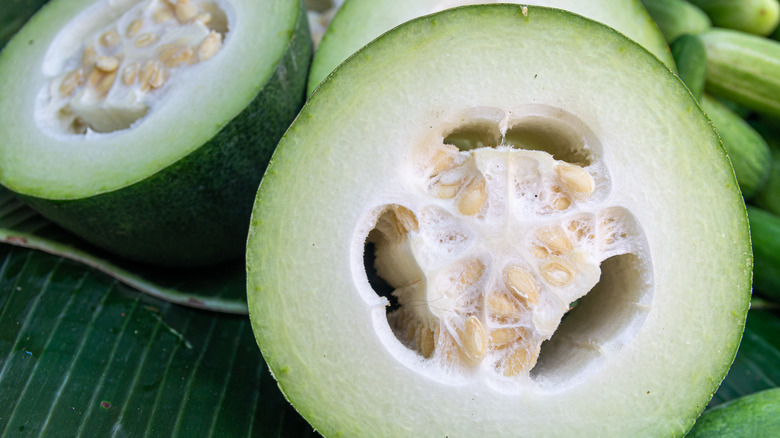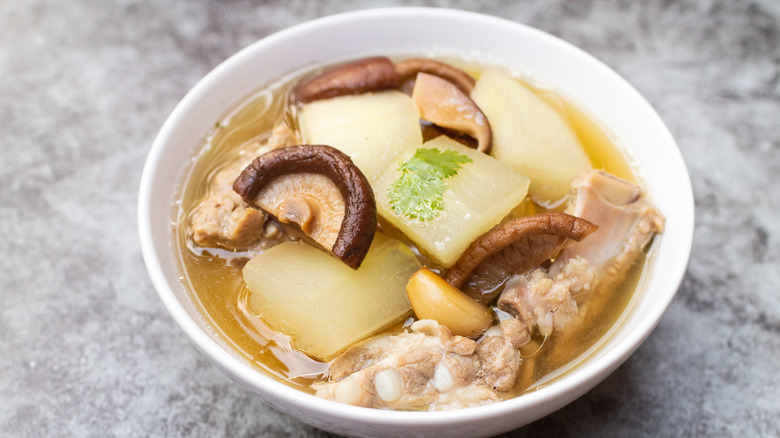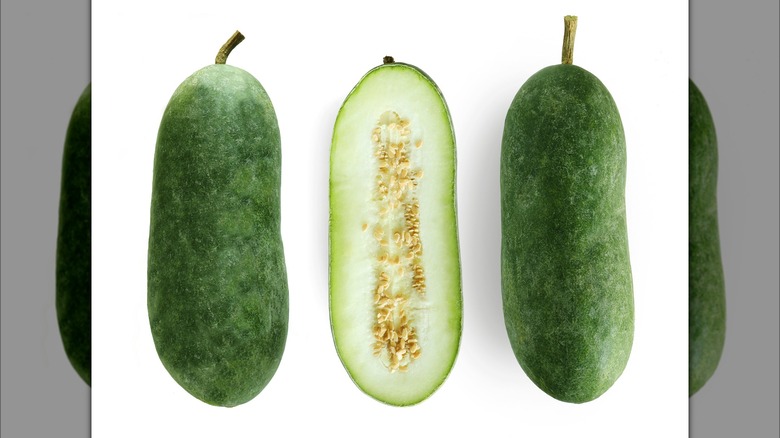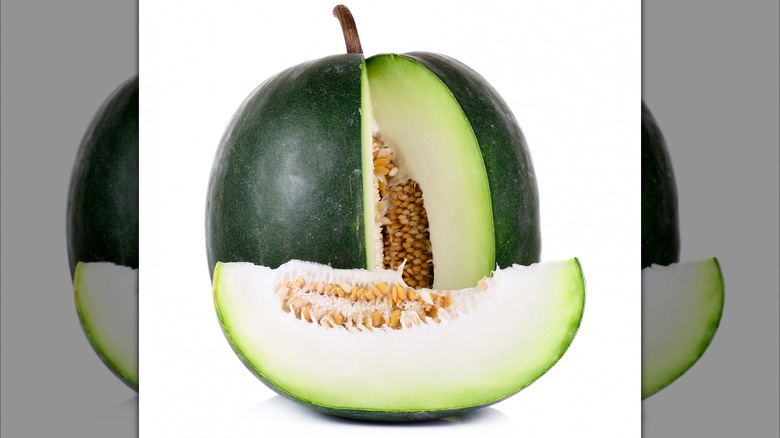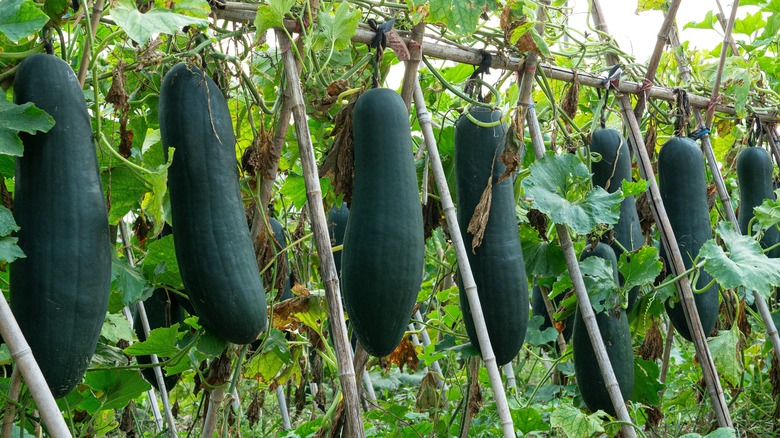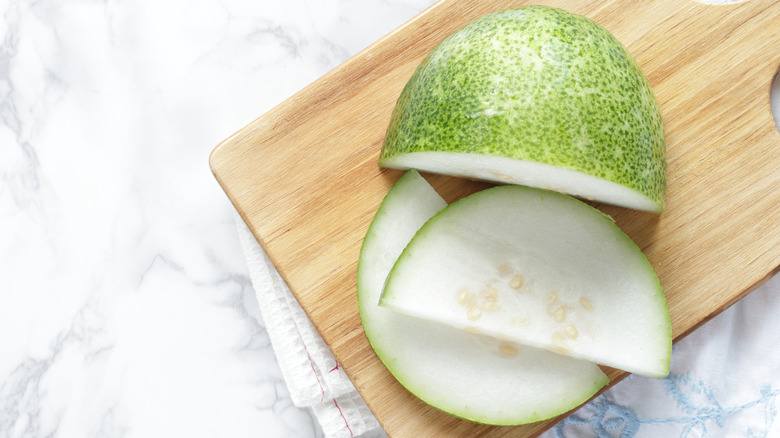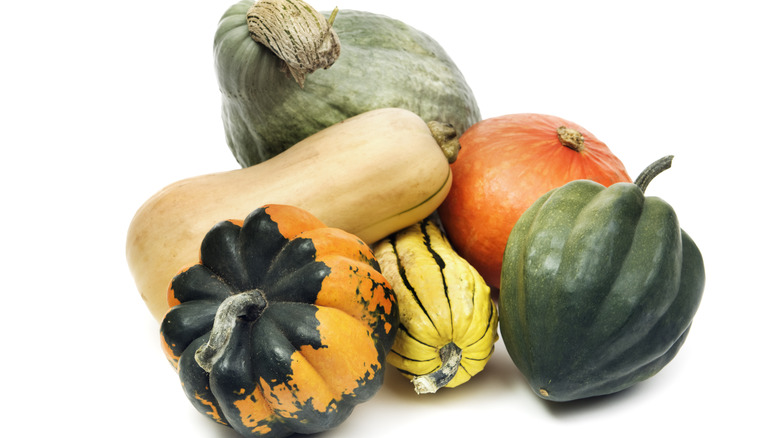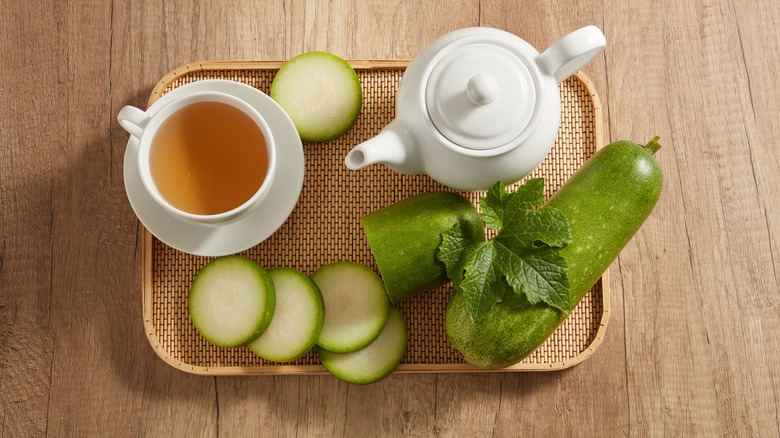What Is Winter Melon And How Do You Cook With It?
When considering melons, familiar varieties such as watermelons, cantaloupes, and honeydews often spring to mind. Yet, there exists a lesser-known but equally intriguing member of the same family: the winter melon (Benincasa Hispida). This unique gourd, as noted in a 2021 study published in Oxidative Medicine and Cellular Longevity, is known by a plethora of names, reflecting its wide cultural significance and diverse culinary uses. Among its various names are wax gourd, white gourd, Chinese watermelon, ash gourd, kundur fruit, tallow gourd, winter gourd, ash pumpkin, Chinese preserving melon, (alu) puhul, and chalkumra. Each name captures a different aspect of the melon's appearance, texture, or regional usage.
Originating from Southern and Southeastern Asia, the cultivation of winter melons has spread far and wide across the Asian continent and beyond, finding a place in the agricultural practices of countries such as Australia, Sri Lanka, Burma, Japan, Ceylon, and Java. The gourd's adaptability to various climates and soils has contributed to its widespread cultivation. The winter melon's distinct characteristics, such as its size, long shelf life, and unique flavor profile, have made it a valued ingredient in an array of traditional Asian dishes. Its cultural importance is further evidenced by its numerous names, each reflecting the melon's integration into the local cuisines and agricultural traditions of these regions.
What is winter melon?
The winter melon is an intriguing gourd that grows on vines and bears a slight resemblance to the watermelon in terms of color, shape, and size. Despite these superficial similarities, winter melons diverge significantly from watermelons in both taste and culinary uses. In fact, their closer kinship lies with cucumbers, in both texture and flavor profiles. This unique vegetable is primarily made up of water, comprising an impressive 96% of its composition. Its high water content contributes to its refreshing taste and crisp texture, making it a popular ingredient in a variety of culinary preparations.
Predominantly featured in Chinese, Indian, and other Asian cuisines, the winter melon holds a place of importance due to its versatility and nutritional value. In Chinese cooking, it's often used in savory dishes such as soups and stews, where it absorbs the flavors of the accompanying ingredients while retaining a subtle, mild taste of its own. Indian cuisine, on the other hand, utilizes winter melon in both sweet and savory contexts, showcasing its adaptability to different flavor profiles. The gourd's ability to blend seamlessly into a variety of dishes, while providing a hydrating and low-calorie option, makes it a favored choice in these rich culinary traditions.
How to grow winter melons?
Winter melon plants favor locations that are bathed in sunlight, an essential factor for their growth and fruit development. The quality of the soil plays a crucial role as well; it must be rich in nutrients and have excellent drainage to prevent waterlogging, which could adversely affect the plant's health. To enhance the soil's fertility and structure, gardeners are advised to incorporate organic materials such as compost and apply appropriate fertilizers. These preparations create an ideal environment that fosters robust growth, ensuring the winter melon plants have all the necessary nutrients for their development.
Precision in planting depth and spacing is key for optimal growth when it comes to sowing winter melon seeds. The seeds should be planted at a depth of 1 to 1½ inches, which is ideal for germination and root development. Additionally, spacing is a crucial aspect to consider. Maintaining about 4 feet of space between the rows is recommended to ensure adequate air circulation and sunlight exposure. Proper spacing also reduces the competition for nutrients and water. By adhering to these guidelines, gardeners can successfully cultivate winter melons and enjoy their bountiful yield.
Winter melon vs watermelon
Winter melon and watermelon not only sound alike, but they are also both members of the Cucurbitaceae family. These gourds are notably high in water content, which contributes to their hydrating properties. Watermelon, a familiar summer fruit staple, consists of about 92% water, making it a popular choice for refreshment and hydration. Winter melon surpasses this, with a water content of 96%. Because of their high water content, both gourds are low in calories, making them a healthy addition to various diets. However, despite these similarities, winter melon and watermelon exhibit significant differences in taste and culinary applications.
Winter melon, known for its mild and cucumber-like flavor, is a versatile ingredient in Asian and Indian cuisines. Unlike watermelon, which is predominantly consumed raw due to its sweet taste, winter melon is not typically eaten raw.
Another notable difference is the storage life of these relatives. Winter melon has a considerably longer shelf life compared to watermelon, with the shelf life being around 3 weeks for watermelon and about 4 to 6 months for winter melons when stored properly. This characteristic, combined with its unique taste and culinary flexibility, makes winter melon a distinct and valued gourd in various cuisines.
Can you dry winter melon?
The process of drying winter melon offers a method to intensify and alter its flavors. The procedure begins with thoroughly washing and quartering the winter melon, followed by slicing it into thin ¼-inch to ½-inch pieces. This thickness is ideal for drying, as it allows for even dehydration while retaining the melon's inherent qualities. After slicing, it's crucial to pat the pieces dry with a paper towel, removing any excess moisture. This ensures a more effective, uniform drying process.
For the drying itself, a conventional oven or a specialized food dehydrator can be used. The melon slices can be dried to various textures, from slightly chewy to extremely crispy, which allows for a range of culinary uses. After drying, the slices should be allowed to cool and then stored in a sealed container for about a week to rest. During the resting period, the container should be shaken each day to ensure the dried melon pieces don't stick together and to see if any excess moisture has been left in the dried product. If that's the case, the melon needs to be dehydrated again. Once fully dried and rested, the dried melon can last for around six to 12 months if stored correctly. It's a good idea to label the container with the date the fruit was dried to know how long it should last.
What do winter melons taste like?
Winter melon is often compared to a cucumber due to its subtle and delicately mild flavor. Its somewhat bland taste is actually one of its greatest culinary strengths. This characteristic allows it to function as a chameleon, adept at absorbing and enhancing the flavors of other ingredients in a dish. Its non-overpowering taste makes it an exceptionally versatile ingredient, complementing other flavors without dominating them like tofu, rice, and potatoes.
The taste of winter melon varies depending on its maturity; one that is fully matured and ripe offers a flavor reminiscent of the white part of a watermelon's rind, providing a refreshing and light taste that is ideal for adding a subtle flavor and texture to dishes. On the other hand, the younger winter melon carries a noticeably sweeter taste, akin to the flavors found in fruits such as cantaloupe or honeydew. This variation in taste between the mature and immature winter melon adds to its appeal, allowing it to be used in different culinary contexts, from sweet to savory.
How to cook with winter melons
Winter melons can be incorporated into an array of dishes, ranging from soups and stir-fries to braised dishes and even beverages. Before cooking, it's crucial to remove the hard, waxy skin and seeds. For stir-frying, the melon should be sliced thinly, while medium to large cubes are more suitable for braising, and larger chunks work best in soups. A notable attribute of winter melon is its ability to take on flavors of other ingredients. When in the mood for soup, you can combine broth or stock with a protein (pork ribs if you want to be traditional) and winter melon, being sure to add ginger and other seasonings too.
Another way to enjoy winter melon is in tea form. This involves boiling the melon with sugar to create a syrup, which can then be mixed with water or milk tea for a refreshing beverage. Additionally, braising winter melon with minced pork is an excellent culinary choice. The subtle flavor of the melon pairs well with the richness of the pork, creating a harmonious balance of tastes and textures. Each of these recipes showcases the adaptability of winter melon, allowing it to be a standout ingredient in a wide range of culinary creations.
Where to buy winter melons
For those looking to add this unique ingredient to their culinary repertoire, the best places to start are local Asian markets or specialty stores. When selecting the perfect winter melon, shoppers should keep an eye out for those that are dense and firm to the touch. Those are more important to consider, as opposed to other visual tests that shoppers may use when buying produce. It's also important to inspect it for any external flaws, such as areas with mold or bruising. However, if you notice a few cracks around the melon's end, this means it's ripe! There may also be a slight smell to the melon, but this isn't too common.
For convenience, some Asian markets or specialty stores may offer pre-sliced winter melons, saving on prep time, especially for beginner cooks or busy chefs. Whether purchasing a whole melon or opting for pre-sliced packages, it's a great addition to a variety of dishes, offering a unique flavor and texture.
Nutritional information for winter melons
A 1-cup serving of raw winter melon contains only about 17 calories, and in terms of macronutrients, it contains less than 1 gram of protein and fat and nearly 4 grams of carbohydrates and fiber. This nutrient profile makes it a light and easily digestible food, suitable for a variety of dietary needs.
Despite its low macronutrient content, winter melon offers significant health benefits due to its micronutrient composition according to a 2021 study published in Oxidative Medicine and Cellular Longevity. It is a decent source of vitamin C, which is crucial for immune system function, skin health, and iron absorption. Additionally, winter melon contains flavonoids and carotenes, which are potent antioxidants. These compounds may play a critical role in protecting the body against various diseases and conditions such as heart disease and type 2 diabetes. This combination of low calories, minimal macronutrients, and beneficial micronutrients makes winter melon a valuable addition to a health-conscious diet, providing essential nutrients while promoting overall well-being.
Varieties of winter melon
According to a 2021 study published in Oxidative Medicine and Cellular Longevity, as many as 825 species in the Cucurbitaceae family have been documented (at the time of the study). For winter melon specifically, it's unknown exactly how many varieties there are; however, a 2016 study by Michigan State University explored eight varieties aiming to determine consumer preferences among these diverse types. The varieties tested were Large Round, Large Oblong, Hybrid Small Round, Hybrid Wonder Wax, Hybrid Thai Small, Hybrid Thao Nuan, Long Giant, and Southern Dark Skin.
Each of these exhibits specific features in terms of size, shape, and skin texture, contributing to their identities. Out of those tested, Large Round was found to be the most favored by shoppers due to its larger size. Hybrid Small Round wasn't a top pick for shoppers because the melon was small and its fruit inside wasn't very plump.
How to harvest winter melons
Typically, winter melons reach maturity and are ready for harvest either at the end of summer or beginning of fall. One of the key signs it is ripe for harvesting is a noticeable change in the rind's color, which will transition from a lighter shade of green to a darker hue. Additionally, the appearance of small cracks near the blossom end of the melon is another reliable indicator of ripeness.
Winter melon differs from other melons in terms of how it detaches from the vine. Other varieties of melons, such as cantaloupe, have stems that separate easily when ripe. This is called "full-slip". The stem of the winter melon does not, known as "non-slipping." This means that when harvesting, the stems must be cut intentionally. When the melon is harvested improperly, you risk compromising the fruit's integrity and causing unnecessary damage.
How to store winter melons
Renowned for its impressive shelf life, the winter melon got its name from its ability to remain edible and fresh long after its summer or early fall harvest, lasting well into the winter months. It can remain unspoiled for around 4 to 6 months if stored properly and maintained its quality when stored at 68 degrees Fahrenheit, according to a 2022 study published by the Journal of Food Quality.
If you purchased a whole winter melon, it's best to leave it whole and unwashed before storing it in a cool, dark place. It's important to leave whole ripe winter melons unwashed because of the white wax coating that naturally occurs on its exterior, which acts as an additional barrier against possible diseases. Once sliced, it can last for around 1 week if stored in a fridge and wrapped in plastic or placed in an airtight container, ideally in your fridge's crisper drawer. It's also possible to pickle winter melon as a way of making it last longer.
Vegetables related to winter melon
Winter melon is a member of the Cucurbitaceae family, commonly referred to as the gourd family. This large family encompasses a wide range of vegetables and fruits and has an estimated 975 species! Winter melon shares its lineage with several other less commonly known members such as bittermelon, snake gourd, opo or bottle gourd, sinqua, kabocha, and moqua, also known as either fuzzy gourd or hairy melon.
Alongside these, the gourd family also includes more familiar vegetables such as cucumbers, gherkin, chayote, zucchini, watermelon, muskmelon, colocynth, bur cucumber, bryony, and loofah. Additionally, this family extends to include pumpkins, winter squashes, yellow-flowered gourd, and calabazilla, which is grown in the Southwestern part of the United States. Most, if not all, members of the gourd family thrive in tropical and temperate environments and produce tendrils and vines that branch out and grow quickly, as well as showy, bright white or yellow flowers.
Health benefits of eating winter melons
While there are potentially some health benefits of consuming winter melons, research in this area is still emerging and not extensive. A 2012 study published in the Journal of Advanced Pharmaceutical Technology and Research, which was conducted on rats, found that winter melon had a beneficial effect in reducing stomach ulcers, suggesting a potential role in gastrointestinal health. Similarly, a 2009 study published in Vascular Pharmacology observed the effects of Benincasa Hispida (the scientific name for winter melon) on human umbilical vein endothelial cells (HUVEC). This study showed that the melon could reduce inflammation, indicating its potential anti-inflammatory properties.
Despite these findings, it's important to recognize that the winter melon is still a subject of ongoing research, and many of its purported health benefits have yet to be scientifically confirmed. Current knowledge accepts it as a low-calorie and hydrating fruit, which could contribute to its health benefits. The fruit might play a role in aiding digestive health, maintaining hydration, managing weight, and helping to keep blood sugar levels at optimal levels. While winter melon may have health benefits, they are not yet fully confirmed due to the limited scope of current studies, and ongoing research is expected to provide a more comprehensive understanding of these benefits.
